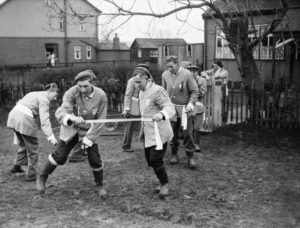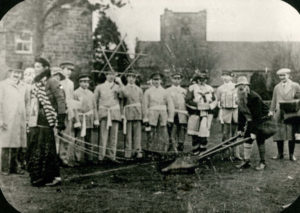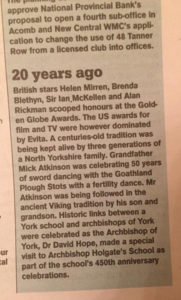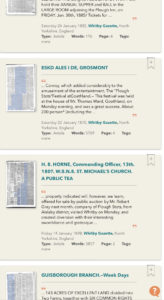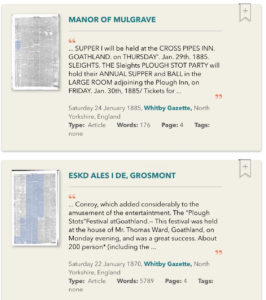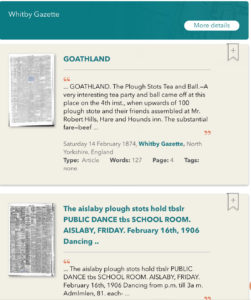Over the many years that the Goathland Plough Stots have been in existence many articles have been written about them by different authors. You might say that some are true, some could be true and some are only guesswork. Well since I started building the web site for the Plough Stots I have come across many different theories, stories and fables. One thing’s for sure – you can guarantee that the material Mr F.W.Dowson BA scribed is as true as you can get. The retired schoolteacher lived at New Wath on his return to Goathland and revived The Goathland Plough Stots in 1922.
Being a dancer with Goathland Plough Stots since 1966, I am one of those dancers that do not remember “the good old days” of Mr F.W. Dowson, Harry Eastern, Tom Atkinson, Max Graham, Jack and Ike Scarth, Napper Noble etc. I do remember them dancing, but at the time never dreamt that I would ever get to do it myself.
Jack Scarth ran the village youth club when I was in my early teens, and there were only six boys in the village that went to the youth club on a Friday night: Robin and Timmy Reeves, Alistair Jozefowicz, Gary Smith, Paul Spenceley and myself.
Keith Reeves, already a dancer (somewhat 5 years older than us) in the senior team but probably the youngest member of that team, seemed like a hero to us as we tried to come to terms with “double unders”, “double overs” and all the other dance jargon that Mr Scarth tried to get us to understand.
We used to practice in the Parish Room (The Plough Stots had not become custodians of the Reading Room at this time, that happened in about 1975) before, during or after youth club depending on what mood Mr Scarth was in and what shift he was doing at the Hydro (now the Inn On The Moor). We would practice to the music from an old gramophone, until we got Peter Hugill to play the harmonica for us (his father Geoff used to play for the senior team). Colin Barker (my next door neighbour at Thornhill) who played several instruments also joined the gang and played for us.
We danced at a few outings but one, which always stands out in my mind, was when we went to Eaglescliffe (Middlesbrough) to dance at a fete in 1969 or 1970. We left Goathland on a coach carrying three teams. The seniors were (young) Jimmy Sleightholme, Mick Atkinson, George Dowson, Jim Graham, Keith Reeves and Ian Mcaig; the juniors Robin and Timmy Reeves, Alistair Jozefowicz, Mike Nessfield, John Bell & myself. The infant team pulling the plough were Gordon Sleightholme. Mike Sleightholme, Andrew Fletcher, David Atkinson, Roy Barton and Anthony Hugill. Jack Scarth was the Gentleman with the banner.
In contrast, nowadays we are trying to make the trips a bit more adventurous, such as to the Fasanc festival to be with our good friends Podsable Komna in the Czech Republic (2005), and the International Sword Spectacular 2004. Also we have a good team of younger dancers coming through under the guidance of Mr Keith Thompson & Malcolm Worley (both old timers of the team).
Many questions I have been asked over the years I could answer only by either what I have read or have been told. This may be right or could be a misinterpretation of how someone has perceived the story in the first place. One of the questions frequently asked is “How long has Goathland had a sword team”. I dare anybody to answer that truthfully. A lot of people think it was from 1920, but that was when Mr F,W,Dowson (with the help of Major Fairfax-Blakeborough and Cecil Sharp) resurrected the sleeping Goathland dance; in fact the sword dance was a accompaniment to the mummers play going back to the early 1800’s or earlier. Unfortunately all the records were lost in a fire around 1850. But whatever year they actually started there is one thing for sure: they are the oldest team dancing their own traditional dance in England today (I don’t mean the dancers’ actual age!).
It has also been said that Goathland had a third colour of tunic (some say orange, as has been written in a document by Trevor Stone), and that the tallest members wore orange, the next size down wore blue and the smallest members of the team wore red (pink). Another theory was that we had the third colour of beige or sack-cloth colour to placate the Roman Catholics. In fact I think this has got muddled up with the fact that when two dancers from the Egton team started dancing for Goathland they just kept their old tunics; just as Mr Harry Easton was often seen dancing in light coloured trousers when the fact was he had probably just come from a cricket match.
It was said in the early days of the dancing that the men folk wore their shirts over their jackets tied off with a tie round their waist. But the Pink arrived from the faded Red, as the Blue & Red were the colour of the two political parties. There is a story that when Goathland Plough Stots were dancing in Whitby a dancer went to collect a donation from a household, which was a supporter of the opposite colour; so they heated a coin in the fire before dropping it into his open hand! So the colours have ended up pink and pale blue to save any harm to our dancers and any embarrassment to people donating to the wrong colour. Or could it simply be that a boil wash is too hot for colours, which are not fast?
In 1953 Loftus Urban District Council Coronation Souvenir Yearbook references that a Goathland Plough Stot by the name of Ventress taught the Loftus men to dance, which goes to show that as people moved around so could the dances, perhaps with a bit of variation.
We have in our possession two certificates, both of First Prizes at the Eskdale Folk Dance Competition from 1923 & 1924; one is for the junior team. So within the first couple of years after the revival of 1922 Mr F.W.Dowson BA had whipped them into shape good enough to start winning competitive competitions. Mr F.W.Dowson so praised and publicised the existence of the Goathland Plough Stots and their attainment of high standards that he actually got a sword dancing team on the radio (before television was invented)!
Another question that gets asked is “What does the dance mean?” Well this is a hard one to answer truthfully. If you go with the “tradition”, the sword dancing is of farming folk where over the winter months the youngsters used to make candles, which they took to church on Epiphany (12th night). The following week the dancers would dance around the village for donations to cover the cost of making the candles & to buy seeds for the yearly crops. If they did not get a donation the “stots” would plough a furrow down the front lawn to let other villagers know that the household did not donate; if they did get a donation the Bessy would sweep the front porch with her besom. Another idea is that it was a sacrificial dance around either a bush, tree or sacrificial offering; when the swords had been made into a lock and the rose lifted, the “king” then lowered it over the head of the sacrifice (either a goat or village virgin, depending on whether a male or female is telling the story!) and then the swords withdrawn from around the neck. Hence the “pagan” aspect. A third interpretation is a fertility dance to ask for good and plentiful crops, as described by Mr Keith Thompson in the Newsd’esk (Spring 2000): “ Dancing around a sacred stone or tree, the rhythmic clashes of the swords driving out evil spirits from the area prior to the dance commencing. The formation of the circle, swords held hilt to tip keeping malevolence at bay, culminating in the formation of the sword lock which was then placed around the neck of the sacrifice tied or held to the sacred object before finally spilling the blood of the offering on to the ground.”Whichever one believed, we could only know the answer if we could ask the Vikings who brought it to our shores.
The findings and thoughts are purely my own and may not be those of other members of The Goathland Plough Stots.
The following article was written by the late Frank Dowson B.A. a retired schoolteacher who came to live back in the village in the early 1920’s and was instrumental in reviving the sword dances of Goathland.
“The word “STOT” means bullock, and this was the name transferred from the animals formerly used for draught purposes to the young men who dragged a plough on their rounds of the village on plough Monday, the Monday following 6th January (Epiphany). It was on the Feast of the Epiphany that the men made their offerings of candles and other gifts at the church alter. On Plough Monday they took out a plough and solicited offerings for their outlay in providing the candles and gifts. They shouted and sang as they went on their rounds, and gradually a sort of rude pageant or play came into being .In time a “Lord” and “Lady” or “Gentleman” and “Lady” appeared at the head of the company, with collectors (known locally as “Toms”), and an old couple, “Isaac” and “Betty” ( “T’awd man”, and “T’awd woman”) brought up the rear. It is not known when teams of Sword Dancers joined the Plough Stot companies, but such would almost naturally follow in the course of time. The Sword Dancers had quite distinct origin however, and such ritual dances have been in existence from time immemorial. Our Long Sword Dances of Yorkshire (there are short swords, called “rapper” or “rapiers” in Durham and Northumberland) are derived from Scandinavian countries, where they existed up to the time of the Reformation. They were introduced into Northern England and the Shetland Islands more than a thousand years ago. It is heartening to know that such splendid dances still exist both in North Yorkshire and in the Shetlands Islands. Both the districts were colonised by Norsemen, and a strong Norse elements still exist, alike in North Yorkshire and the Northern Isles. Most villages or districts in North Yorkshire formerly had Sword Dance teams accompanying the Stots or the Mummers. These teams have all died out in course of time with the exception of those of Goathland and Sleights, and the last named company has not gone out in recent years. Hence Goathland is the only remaining team of it’s kind in England. Fortunately many excellent sword dance figures have been kept e.g. Kirby Malzeard, North Skelton, and Lingdale, whilst others are occasionally practised. Would that more full companies were reconstituted. Our Goathland team had been in abeyance for some forty years when I conceived the idea of reviving the company after I had unsuccessfully tried to find the manuscripts of the old Goathland play. In this I tried to help my old friend the late Cecil Sharp, the founder of the England Folk Dance and Song Society, now so strongly established. The local efforts from 1920 onwards took more than two years to materialise, but at last in April 1922, with the help of Major J.Fairfax-Blakeborough, the Goathland Plough Stots were launched. The first team, trained by a Sleights man in that year ( there were no Goathland men left who could perform the whole set of figures) went out in January 1923, and was a great success. All the figures have been recovered and danced, as in the olden days and we hope the pageant of the Plough Stots will now be preserved permanently. There are six figures including “No Man’s Jig.” I have omitted to say that the round dances, ritualistic in origin, date back to pagan times, when people danced round a sacred tree, stone, bush, or human victim about to be sacrificed. The clash of the swords is an indication of this, as is also the entry and slaying of “Isaac” (“T’awd Man”) in the middle of the swords, when they are locked; on the withdrawal of the swords by each man the old victim falls down and is slain. Our Goathland team has gone out regularly with one exception since it’s inception in 1923. The war interrupted such activities, of course but 1947 has witnessed a bigger interest than ever. The team of dancers have competed in many tournaments, and have also collected many scores of pounds for the local hospital, in 1935 the company broadcast from Leeds. The present team with full pageantry will visit Kirk Museum in York very shortly to give an exhibition amongst the “Bygones.”
